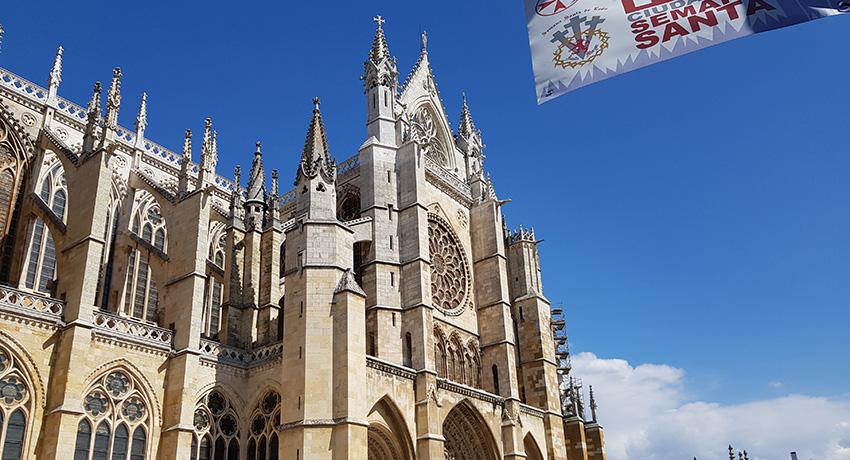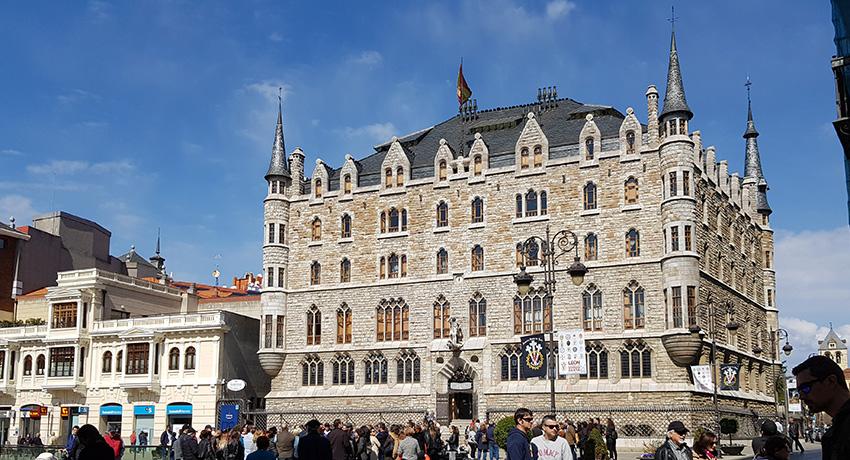Leon, a Beacon of Camino History
If you are looking for a destination that combines history, culture, nature and gastronomy, you should consider starting your Camino in León. León is a city with a great Jacobean tradition and the second most popular starting point of the Camino de Santiago every year. In this article, I will share some of the reasons why you should visit León and what to see and do in this beautiful city.
León's History and Sights
León was founded by the Romans as a military camp and later became the capital of the kingdom of Castile in the Middle Ages. It has a rich heritage that reflects its importance throughout history. One of its most emblematic monuments is the Cathedral, also known as the Pulchra Leonina or the "Sistine Chapel" of Spanish architecture.
The Cathedral is a masterpiece of Gothic art that boasts 125 windows and 57 oculi producing an area of stained glass over 13,000 square feet.
The stained-glass windows produce a breathtaking swirl of color and light that will leave you speechless. The Cathedral also houses a museum with valuable works of art, such as paintings, sculptures, tapestries and relics. You can visit the Cathedral for 6 euro or get a combined ticket with other attractions for 10 euro.
Another must-see in León is the San Marcos Hostal, a Parador hotel that will take your breath away with its serene magnificence. The San Marcos Hostal was originally a monastery and a hospital for pilgrims on the Camino de Santiago. It has a stunning Plateresque facade with sculptures of saints, kings and animals. The interior is equally impressive, with a cloister, a church and a library. You can also enjoy a delicious meal at the restaurant or a relaxing drink at the bar.
The Basilica of San Isidoro is another remarkable sight to visit in León. Built in the 11th century on the site of a Roman temple dedicated to Mercury, it is considered one of the finest examples of Romanesque art in Spain, especially for its frescoes in the Royal Pantheon. The Pantheon is where many kings and queens of León are buried, and it is decorated with paintings that depict scenes from the Bible and the history of León. The Basilica also has a museum with archaeological and artistic treasures that is well worth a visit.
If you are interested in learning more about the history and culture of León, you should visit Casa Botines, a building designed by Antoni Gaudí, one of the most famous architects of modernism. Casa Botines is one of the few works by Gaudí outside Catalonia and it has a neo-Gothic style with medieval influences. It was originally a textile warehouse and a residence for wealthy merchants. Today, it hosts a museum that displays paintings, sculptures, furniture and other objects related to Gaudí and León.

The Camino from León to Ponferrada
León is also a city that offers plenty of natural attractions and outdoor activities. Key amongst them is, of course, the Camino de Santiago. The sixth section of the Camino Frances starts in León and ends in Ponferrada, a town that was built by the Templars in the 12th century. Along this section, you will have the opportunity to visit the hilltop town of Astorga, which is well-known for its sweets and chocolates, along with the Astorga Cathedral and the Pilgrimage Museum. You will also climb the mountains outside León, where you can leave behind a stone (a symbol of your burden) at the foot of the Iron Cross (Cruz de Ferro), one of the most emblematic points of the Camino. You will be able to enjoy the scenic views of the mountainous region of El Bierzo and its vineyards from there.
Events to attend in León
León is not only a city of monuments but also a city that feels alive with joy. You can feel its energy in its streets, squares and bars, where you can mingle with locals and pilgrims alike. León has a lively cultural scene, with festivals, concerts and theater productions throughout the year. Some of the most popular events are:
- Holy Week: León celebrates Easter with solemn processions that carry religious images through the old town. The most famous one is the Procession of the Meeting, which takes place on Good Friday at noon. It represents the encounter between Jesus and his mother Mary after his crucifixion.
- The San Juan and San Pedro Festivities: These are the patron saint festivities of León, which take place from June 23 to June 29. They include concerts, fireworks, bullfights, parades and dances. The highlight is the night of San Juan (June 23), when bonfires are lit all over the city.
- The Purple Weekend: This is a music festival that takes place in December. It features bands and DJs from different genres, such as rock, pop, indie and garage. It also includes a vintage market, exhibitions and workshops.
What to eat in León
Of course, no visit to León would be complete without tasting its delicious gastronomy. León is famous for its cured meats, such as cecina (dried beef), chorizo (spicy sausage) and morcilla (blood sausage). You can also try some of its typical dishes, such as cocido leonés (a stew with meat, beans and vegetables), sopa de trucha (trout soup) or botillo (a stuffed pork intestine). For dessert, you can indulge yourself with some mantecadas (sponge cakes), hojaldres (puff pastries) or chocolate con churros (hot chocolate with fried dough sticks).
León is also a city that has many charming neighborhoods where you can stroll around and discover its hidden gems. One of them is the Barrio Húmedo, or Wet Quarter, which is the old town and the main nightlife area. Here you can find many bars, pubs and restaurants where you can enjoy some tapas (small portions of food) and wine.

The Tapas Festival is an annual event that showcases León's cuisine. It takes place in November and it involves more than 100 bars and restaurants that offer their best tapas for a fixed price. You can taste traditional dishes like morcilla (blood sausage), cecina (cured beef), croquetas (fried balls of béchamel sauce and ham or cheese) or patatas bravas (fried potatoes with spicy sauce), as well as more creative ones. Unfortunately, this is usually late in the year for those of you in a Camino trek, but you can still sample the best of Leon’s cuisine during Spring and Summer, the most popular Camino months.
If you’re ready to venture beyond the typical last 100Km, make León your starting point and be amazed by everything that this city has to offer.



